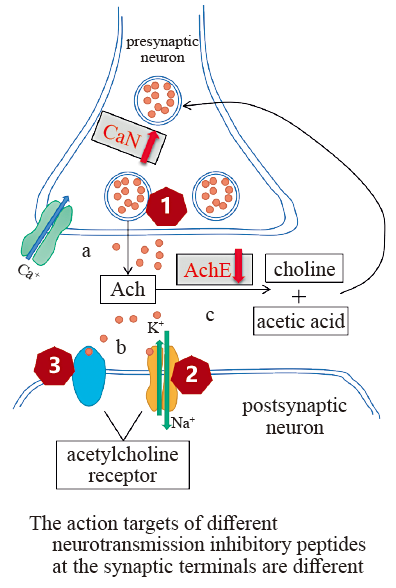With the cosmetics industry entering the high-tech development period, people pay more attention to the maintenance of the skin, especially the sharp increase in the demand for skin texture smoothing and wrinkle desalinization. However, the efficacy evaluation of anti-wrinkle cosmetics or raw materials has the problems of long cycle, high cost and inability to achieve high-throughput detection. Therefore, it is of great significance for product development to establish a feasible and effective alternative detection model, in order to achieve the rapid evaluation of the wrinkle-removing efficacy of cosmetic raw materials. In this study, Caenorhabditis elegans (C. elegans) was used as the model organism to test the inhibitory effects of several kinds of cosmetic peptides on neuromuscular synapses. The movement behaviors of the treated C. elegans were observed and two main enzymes function in neuromuscular junctions, the Acetylcholinesterase (AChE) and the Calcineurin (CaN), were also tested. The results show that, after treatment with all tested peptides (including scorpion venom, snake venom peptide, conotoxin and the compound peptide by scorpion venom and conotoxin), the movement behavior of C. elegans (head swinging and body bending) is inhibited to a certain extent (9%-33%). And the tail muscles can not contract normally, showing the movement state of trailing and crawling. With the intervention of neostigmine methylsulfate, the body bending amplitude of the C. elegans after exercise injury recovers little, and the movement behavior of C. elegans is inhibited about 5%-17%. These data indicate that all of the tested peptides show strong inhibitory activities on normal synapse formation between motor neuron and muscle, with remarkably inhibiting the locomotor behavior of C. elegans. In addition, we further find that these peptides stimulate the overexpression of CaN while inhibiting the enzyme activity of AchE, thereby blocking the functions of neuromuscular junction, which leads to muscles relax and achieves the anti-wrinkle effects. Various types of neurosuppressive peptides have different targets and different action mechanisms for exerting anti-wrinkle activity. Compared with the anti-wrinkle polypeptide with a single target, the polypeptide raw material compounded by the red scorpion element and the cono peptide can exert more excellent anti-wrinkle activity. Furthermore, by testing the movement recovery ability of C. elegans, the head swing frequency of C. elegans recovers to the level of the blank group (P>0.05), which indicates that these neuroprotective peptides have no neurotoxicity to C. elegans, and are immediate and safe. In conclusion, the methods described in this study can provide scientific reference for the development and efficacy verification of anti-wrinkle ingredients for skin care products.



